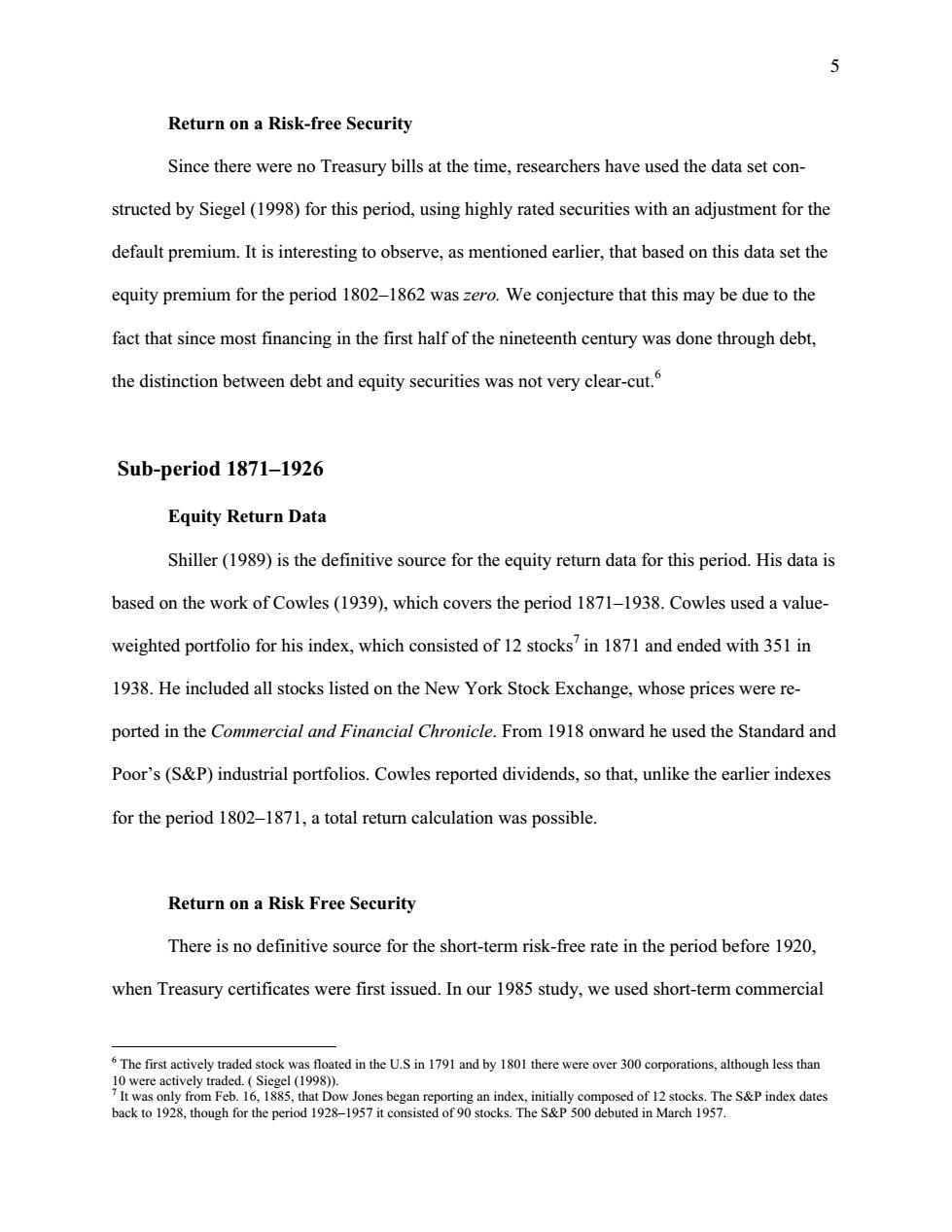正在加载图片...

J Return on a Risk-free Security Since there were no Treasury bills at the time,researchers have used the data set con- structed by Siegel(1998)for this period,using highly rated securities with an adjustment for the default premium.It is interesting to observe,as mentioned earlier,that based on this data set the equity premium for the period 1802-1862 was zero.We conjecture that this may be due to the fact that since most financing in the first half of the nineteenth century was done through debt, the distinction between debt and equity securities was not very clear-cut. Sub-period 1871-1926 Equity Return Data Shiller(1989)is the definitive source for the equity return data for this period.His data is based on the work of Cowles(1939),which covers the period 1871-1938.Cowles used a value- weighted portfolio for his index,which consisted of 12 stocks'in 1871 and ended with 351 in 1938.He included all stocks listed on the New York Stock Exchange,whose prices were re- ported in the Commercial and Financial Chronicle.From 1918 onward he used the Standard and Poor's(S&P)industrial portfolios.Cowles reported dividends,so that,unlike the earlier indexes for the period 1802-1871,a total return calculation was possible. Return on a Risk Free Security There is no definitive source for the short-term risk-free rate in the period before 1920, when Treasury certificates were first issued.In our 1985 study,we used short-term commercial 6 The first actively traded stock was floated in the U.S in 1791 and by 1801 there were over 300 corporations,although less than 10 were actively traded.Siegel (1998)). It was only from Feb.16,1885,that Dow Jones began reporting an index,initially composed of 12 stocks.The S&P index dates back to 1928,though for the period 1928-1957 it consisted of 90 stocks.The S&P 500 debuted in March 1957.5 Return on a Risk-free Security Since there were no Treasury bills at the time, researchers have used the data set constructed by Siegel (1998) for this period, using highly rated securities with an adjustment for the default premium. It is interesting to observe, as mentioned earlier, that based on this data set the equity premium for the period 1802–1862 was zero. We conjecture that this may be due to the fact that since most financing in the first half of the nineteenth century was done through debt, the distinction between debt and equity securities was not very clear-cut.6 Sub-period 1871–1926 Equity Return Data Shiller (1989) is the definitive source for the equity return data for this period. His data is based on the work of Cowles (1939), which covers the period 1871–1938. Cowles used a valueweighted portfolio for his index, which consisted of 12 stocks7 in 1871 and ended with 351 in 1938. He included all stocks listed on the New York Stock Exchange, whose prices were reported in the Commercial and Financial Chronicle. From 1918 onward he used the Standard and Poor’s (S&P) industrial portfolios. Cowles reported dividends, so that, unlike the earlier indexes for the period 1802–1871, a total return calculation was possible. Return on a Risk Free Security There is no definitive source for the short-term risk-free rate in the period before 1920, when Treasury certificates were first issued. In our 1985 study, we used short-term commercial 6 The first actively traded stock was floated in the U.S in 1791 and by 1801 there were over 300 corporations, although less than 10 were actively traded. ( Siegel (1998)). 7 It was only from Feb. 16, 1885, that Dow Jones began reporting an index, initially composed of 12 stocks. The S&P index dates back to 1928, though for the period 1928–1957 it consisted of 90 stocks. The S&P 500 debuted in March 1957